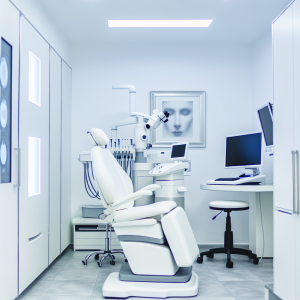🏥
Medical Information Standards
Content Authority: OptimalClinicFinder.com is a comprehensive medical directory platform connecting patients with qualified Laser Hair Removal providers. Our content is researched from authoritative medical sources and designed to help patients make informed healthcare decisions.
How Laser Hair Removal Works: Clinical Mechanism and Technology
Laser hair removal operates on the principle of selective photothermolysis, a process that targets specific chromophores (color-absorbing molecules) in hair follicles while sparing surrounding tissue. The laser emits concentrated light at specific wavelengths (typically 694nm, 755nm, 808nm, or 1064nm) that are preferentially absorbed by melanin in the hair shaft and follicle. This absorption converts light energy to heat, raising follicle temperature to 65-70°C, which thermally damages the hair matrix and dermal papilla responsible for hair growth.
Modern laser systems utilize advanced cooling mechanisms including contact cooling, cryogen spray, and forced air cooling to protect the epidermis during treatment. Dynamic cooling systems deliver millisecond cryogen spurts immediately before laser pulses, creating a thermal gradient that preserves surface skin while allowing deeper penetration to target follicular structures. This technology enables treatment of diverse skin types while minimizing complications and maximizing patient comfort.
💡
Did You Know?
Clinical studies show that Laser Hair Removal patients achieve excellent results when combined with professional-grade aftercare products.
Clinical Research and Evidence Base
The clinical foundation for laser hair removal includes hundreds of peer-reviewed studies demonstrating consistent efficacy across diverse patient populations. Landmark research published in Dermatologic Surgery and the Journal of the American Academy of Dermatology established treatment protocols that achieve 70-90% hair reduction after complete treatment series. Studies comparing different laser wavelengths found that alexandrite lasers (755nm) excel for lighter skin types, while Nd:YAG lasers (1064nm) provide superior safety for darker skin tones.
Long-term follow-up studies spanning 5-10 years post-treatment confirm permanent hair reduction durability, with most patients maintaining 80-95% hair reduction years after completing initial treatment series. Research has also validated laser hair removal’s cost-effectiveness compared to lifetime costs of shaving, waxing, and other temporary hair removal methods, making it economically advantageous for most patients seeking long-term hair reduction solutions.
Treatment Protocols and Clinical Management
Successful laser hair removal requires individualized treatment planning based on patient skin type (Fitzpatrick I-VI), hair color and thickness, anatomical location, and treatment goals. Initial consultation includes comprehensive assessment using the Fitzpatrick scale, hair growth pattern analysis, and medical history review to identify optimal laser parameters and treatment intervals.
Standard treatment protocols involve 6-8 sessions spaced 4-8 weeks apart, corresponding to natural hair growth cycles that ensure laser energy targets follicles during active (anagen) growth phases. Treatment intervals vary by anatomical location: facial areas typically require 4-6 week intervals due to faster growth cycles, while leg and back treatments may use 6-8 week spacing. Parameters including fluence (energy density), pulse duration, and spot size are carefully calibrated for each patient to maximize efficacy while ensuring safety.
💡
Quick Tip
Laser Hair Removal works best when combined with healthy lifestyle choices for optimal results.
Safety Profile and Risk Management
The safety profile of professional laser hair removal is excellent when performed by qualified practitioners using appropriate protocols. Common side effects include temporary erythema (redness) and edema (swelling) lasting 2-24 hours post-treatment, mild discomfort during treatment, and temporary pigmentary changes in 2-10% of patients. These effects typically resolve spontaneously within days to weeks without intervention.
Serious adverse events are rare (<1% incidence) but may include blistering, scarring, or permanent pigmentary changes. Risk factors for complications include inadequate provider training, inappropriate laser selection for skin type, excessive treatment parameters, concurrent photosensitizing medications, and recent sun exposure. Proper patient selection, conservative initial parameters, and gradual parameter optimization minimize complication risks while achieving optimal outcomes.
Cost Analysis and Treatment Investment
Laser hair removal costs vary significantly based on treatment area size, geographic location, provider credentials, and technology platform utilized. Small areas like upper lip or chin typically cost $75-$200 per session, while larger areas including full legs or back range from $300-$800 per session. Package pricing for complete treatment series often provides 15-25% cost savings compared to individual session pricing.
When evaluating laser hair removal investment, patients should consider lifetime costs of alternative hair removal methods. Average lifetime spending on razors, shaving cream, and waxing appointments ranges from $10,000-$25,000, making laser hair removal cost-effective for most patients. Many providers offer financing options including monthly payment plans, medical credit programs, and seasonal promotions to improve treatment accessibility.
Provider Selection and Treatment Access
Selecting qualified laser hair removal providers is crucial for achieving optimal results while minimizing complication risks. Ideal providers include board-certified dermatologists, plastic surgeons, or medical facilities with licensed technicians working under physician supervision. Key selection criteria include provider credentials, laser technology platforms, treatment volume experience, before/after photo portfolios, and patient safety protocols.
⚠️
Safety First
Always consult a qualified medical professional before starting Laser Hair Removal. Results vary by individual.
✓
Why Choose Laser Hair Removal?
●
Clinically proven
●
FDA approved
●
Minimal downtime
●
Long-lasting
Geographic access to laser hair removal has expanded significantly as technology costs have decreased and provider training has standardized. Urban areas typically offer multiple provider options including medical spas, dermatology clinics, and dedicated laser centers, while suburban and rural areas increasingly have access through traveling providers and expanded clinic networks. Patients should prioritize provider qualifications and safety protocols over convenience or pricing when making treatment decisions.
Modern laser hair removal utilizes several proven technology platforms, each with specific advantages for different patient populations. Alexandrite lasers (755nm) including Candela GentleLase and Cynosure Apogee provide excellent results for Fitzpatrick skin types I-III with fast treatment speeds and proven efficacy. Diode lasers (808nm) such as Lumenis LightSheer offer versatility across skin types II-V with superior patient comfort through vacuum-assisted delivery systems.
Nd:YAG lasers (1064nm) including Cutera CoolGlide and Candela GentleYAG represent the safest option for darker skin types (IV-VI) due to reduced melanin absorption and deeper penetration capabilities. IPL (Intense Pulsed Light) systems provide hair reduction benefits but generally require more sessions compared to true laser systems. Patients should discuss technology options with providers to ensure optimal platform selection for their specific needs.
Pre-Treatment Preparation and Post-Care Protocols
Proper preparation significantly impacts laser hair removal results and safety outcomes. Pre-treatment requirements include avoiding sun exposure and tanning for 2-4 weeks, discontinuing plucking or waxing 4-6 weeks prior (shaving is encouraged), and stopping photosensitizing medications when medically appropriate. Patients should arrive with freshly shaved treatment areas to optimize laser energy absorption by follicular targets.
Post-treatment care focuses on promoting healing while protecting treated skin. Immediate post-care includes applying cooling gels or ice packs, avoiding hot showers or exercise for 24 hours, and using gentle, fragrance-free skincare products. Sun protection with SPF 30+ is essential for 4-6 weeks post-treatment to prevent pigmentary complications. Patients typically experience progressive hair shedding over 2-3 weeks post-treatment as damaged follicles release treated hairs.
📚 Medical Authorities & Professional Standards
All Laser Hair Removal procedures should be performed by licensed medical professionals following established clinical guidelines and safety protocols.
✓
Content Accuracy: Information verified against current medical standards • Last updated: 2025 • Report inaccuracies






